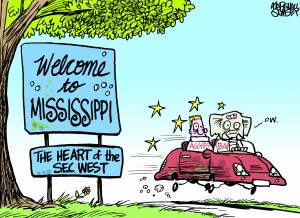 It’s hard to say when the recent low points were for Ole Miss and Mississippi State were but my guess would be the Rebel’s 2010 loss to Jacksonville State and the Bulldog’s 2004 loss to Maine. I could be wrong, but my point is this: To truly appreciate yesterday’s amazing football Saturday, you have to understand exactly how far out of a hole both teams have climbed.
It’s hard to say when the recent low points were for Ole Miss and Mississippi State were but my guess would be the Rebel’s 2010 loss to Jacksonville State and the Bulldog’s 2004 loss to Maine. I could be wrong, but my point is this: To truly appreciate yesterday’s amazing football Saturday, you have to understand exactly how far out of a hole both teams have climbed.
On paper, Ole Miss and State should have trouble competing in the SEC. They’re smaller schools who compete for the same talent pool of recruits. They don’t have the monster facilities that some of the bigger SEC schools have. And of course, both schools don’t have Alabama-like money to play with. Money is the mother’s milk of college athletics after all.
But HOW did both teams turn around so quickly? And how did they do it with so much stacked against them?
1. There was a radical culture change at the top.
This isn’t a comment on Larry Templeton or Pete Boone, but State’s Greg Byrne and Scott Stricklin and Ross Bjork molded their athletic departments into more modern athletic departments. College athletics is big business and today must be run like one. I remember when Bjork was hired, he came on my radio show and talked about his pillars of success. It has been fun to watch him implement them. Both Bjork and Stricklin are energetic professionals and have influenced the culture of their organizations.
2. Hiring coaches who are energetic winners.
Love them or hate them but Hugh Freeze and Dan Mullen compete to win. I remember when Hugh Freeze was hired, people wondered, “who is this guy?” But what critics seemed to miss was that Freeze won at every level he has coached at. He came in with a plan. And stuck to it. Mullen was brash and got under the skin of Ole Miss fans nearly immediately (TSUN) and reenergized the rivalry. Ole Miss responded by bringing in Freeze who immediately became the anti-Mullen. The bottom line? Defeated fan bases became reenergized.
3. Marketing, marketing, marketing.
Both schools have had misfires when it comes to the fan experience but what matters is that they are learning from those mistakes. They are tweaking and trying new things. Ole Miss polls its fans on how to improve game day experience. State creates the hashtag #hailstate to use Twitter in new ways. Constant experimentation leads to a better customer service experience.
4. Surround yourself with great people.
Dan Mullen came in and won the recruiting wars. Then Hugh Freeze came in an won them back. Both brought in enough talented young players who made a difference on the field immediately. You can’t win without energized, talented people surrounding you — in football or business. They built for today while building for the future. That gave fans hope. Which led to:
5. Building on small wins and turning them into big wins.
When State went to Jacksonville for the Gator Bowl and Ole Miss went to BBVA Compass Bowl in Birmingham, it was like National Championship games for the fan base. Because it showed them that after a long drought, things were changing. If you don’t have belief, you won’t have believers. And without believers, you won’t have support and money.
Ole Miss and Mississippi State’s success this weekend is about much more than just football. Their rapid turnaround is something that should be studied and modeled by business leaders and politicians who want to break a culture of failure. Imagine a failng business that hires a brash new leader who brings in motivated executives, hires good people, uses marketing to find out how they can serve their customers better and builds on small victories. I can’t imagine them doing anything but succeeding. Or imagine a government leader who makes his or her constituents believe again. You won’t be 49th for long.
Yesterday was an amazing day for football in Mississippi. But I can’t help but think it was a bigger lesson for us all.
